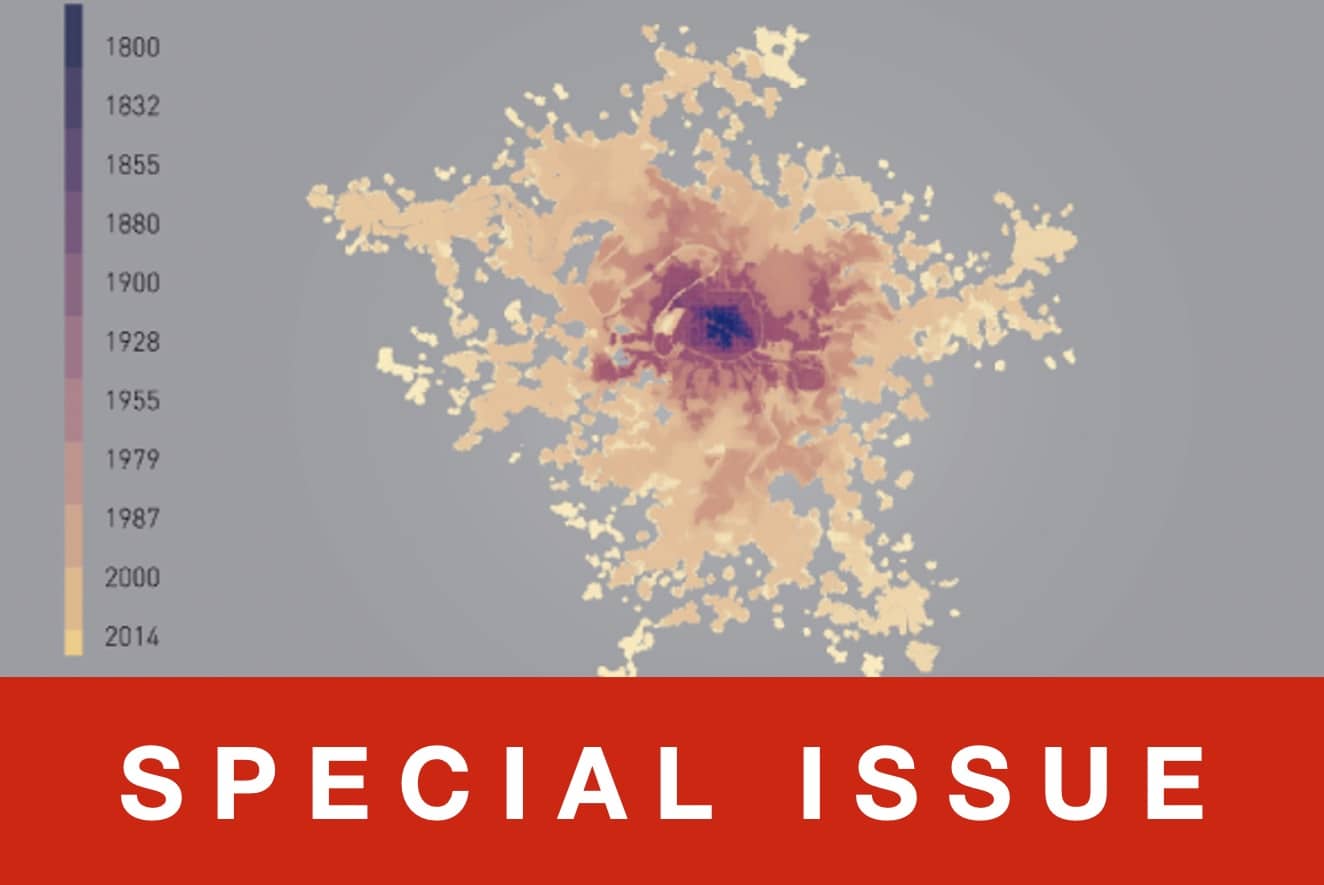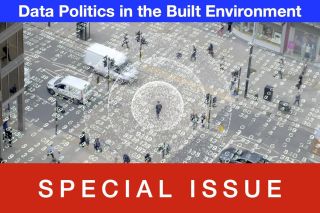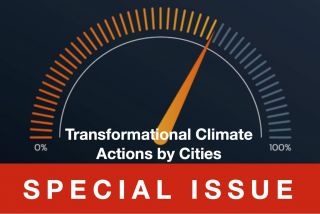
www.buildingsandcities.org/journal-content/special-issues/urban-expansion2.html
Urban Expansion

This special issue examines how cities in the Global South can predict & manage their expansion in effective, sustainable ways.
Urban population growth, now largely confined to the Global South, requires cities to implement effective strategies to accommodate many more people and to ensure that they live productive, healthy, and satisfying lives. The limited potential of infill and densification inevitably requires the conversion of very large areas in the surrounding countryside to urban use. This special issue considers how this can be done in an orderly, efficient, and inclusive manner, with conservation and climate change in mind.
Guest Editor: Shlomo (Solly) Angel
Making room for accommodating growth in cities is a two-pronged strategy: facilitating and promoting densification while, at the same time, preparing lands at scale for sustainable urban expansion in their periphery. Urban expansion in geographic space is often ill-defined and its measurement and projection into the future are controversial. 'Sprawl' is detrimental to the surrounding countryside, costly in terms of infrastructure, excessive waste in energy and resources, and increased GHG emissions. But the regulatory containment of urban expansion is problematic as it can result in land and house price inflation, making cities less affordable. When regulation or enforcement are weak, expansion occurs in a detrimental manner.
There is a window of opportunity currently that allows cities in the Global South to guide and shape their form-making them more productive, more inclusive, and sustainable while they are growing. Preparing for urban expansion with climate change in mind can ensure that expansion is not car-centric and that expansion areas are planned with broader Sustainable Development Goals (SDGs) in mind.
This special issue explores:
- whether and where preparing for urban expansion is appropriate
- how urban expansion can be undertaken more sustainably
- how and where expansion needs to be contained
- what are the appropriate strategies for balancing densification and expansion
- how the appropriate expansion strategies can be effectively implemented.
Lessons and guidance are provided for improved anticipation and planning for urban expansion. A sensible strategy is to prepare lands for expansion, and to prepare them with climate change in mind. As this special issue makes clear, this involves planning for expansion by focusing on simple strategic measures that local authorities can undertake (e.g. arterial roads, removing obstacles to transit-oriented densification along these arterial roads, facilitating land subdivision with small blocks, an adequate amount of land in streets in both formal and informal neighborhoods, protecting areas of high environmental risks as well as ecological assets from development, and ensuring the creation of a hierarchy of green public open spaces).
Urban expansion should not be perceived as an unpleasant burden to be avoided, resisted, or ignored. Instead, it is an opportunity and a challenge, with multiple benefits to be realized in coming decades if done correctly.
Table of Contents
Urban expansion: theory, evidence and practice
Shlomo Angel
Complexifying urban expansion: an exploratory,
gradient-based approach
Steven M. Richter, R. Patrick
Bixler
Urban growth in peri-urban, rural and urban areas: Mexico
City
Gustavo Manuel Cruz-Bello, José
Mauricio Galeana-Pizaña, Salomón González-Arellano
Urban encroachment in ecologically sensitive areas: drivers,
impediments and consequences
Manja Hoppe Andreasen, Jytte
Agergaard, Richard Yao Kofie, Lasse Møller-Jensen, Martin Oteng-Ababio
Socioeconomic and livelihood impacts within Bangkok's expanding metropolitan region
Gregory Gullette, Paporn
Thebpanya, Sayamon Singto
Planning gaps: unexpected urban expansion in five Colombian
metropolitan areas
Maria Monica Salazar Tamayo,
Johann Dilak Julio Estrada
Implications of urban expansion: land, planning and housing
in Lagos
Basirat Oyalowo
The urban expansion of Berlin, 1862-1900: Hobrecht's Plan
Felix Bentlin
The Ethiopia Urban Expansion Initiative and knowledge
exchange
Patrick Lamson-Hall, Richard
Martin
Latest Peer-Reviewed Journal Content
A living lab approach to co-designing climate adaptation strategies
M K Barati & S Bankaru-Swamy
Mediation roles and ecologies within resilience-focused urban living labs
N Antaki, D Petrescu, M Schalk, E Brandao, D Calciu & V Marin
Negotiating expertise in Nepal’s post-earthquake disaster reconstruction
K Rankin, M Suji, B Pandey, J Baniya, D V Hirslund, B Limbu, N Rawal & S Shneiderman
Designing for pro-environmental behaviour change: the aspiration–reality gap
J Simpson & J Uttley
Lifetimes of demolished buildings in US and European cities
J Berglund-Brown, I Dobie, J Hewitt, C De Wolf & J Ochsendorf
Expanding the framework of urban living labs using grassroots methods
T Ahmed, I Delsante & L Migliavacca
Youth engagement in urban living labs: tools, methods and pedagogies
N Charalambous, C Panayi, C Mady, T Augustinčić & D Berc
Co-creating urban transformation: a stakeholder analysis for Germany’s heat transition
P Heger, C Bieber, M Hendawy & A Shooshtari
Placemaking living lab: creating resilient social and spatial infrastructures
M Dodd, N Madabhushi & R Lees
Church pipe organs: historical tuning records as indoor environmental evidence
B Bingley, A Knight & Y Xing
A framework for 1.5°C-aligned GHG budgets in architecture
G Betti, I Spaar, D Bachmann, A Jerosch-Herold, E Kühner, R Yang, K Avhad & S Sinning
Net zero retrofit of the building stock [editorial]
D Godoy-Shimizu & P Steadman
Co-learning in living labs: nurturing civic agency and resilience
A Belfield
The importance of multi-roles and code-switching in living labs
H Noller & A Tarik
Researchers’ shifting roles in living labs for knowledge co-production
C-C Dobre & G Faldi
Increasing civic resilience in urban living labs: city authorities’ roles
E Alatalo, M Laine & M Kyrönviita
Co-curation as civic practice in community engagement
Z Li, M Sunikka-Blank, R Purohit & F Samuel
Preserving buildings: emission reductions from circular economy strategies in Austria
N Alaux, V Kulmer, J Vogel & A Passer
Urban living labs: relationality between institutions and local circularity
P Palo, M Adelfio, J Lundin & E Brandão
Living labs: epistemic modelling, temporariness and land value
J Clossick, T Khonsari & U Steven
Co-creating interventions to prevent mosquito-borne disease transmission in hospitals
O Sloan Wood, E Lupenza, D M Agnello, J B Knudsen, M Msellem, K L Schiøler & F Saleh
Circularity at the neighbourhood scale: co-creative living lab lessons
J Honsa, A Versele, T Van de Kerckhove & C Piccardo
Positive energy districts and energy communities: how living labs create value
E Malakhatka, O Shafqat, A Sandoff & L Thuvander
Built environment governance and professionalism: the end of laissez-faire (again)
S Foxell
Co-creating justice in housing energy transitions through energy living labs
D Ricci, C Leiwakabessy, S van Wieringen, P de Koning & T Konstantinou
HVAC characterisation of existing Canadian buildings for decarbonisation retrofit identification
J Adebisi & J J McArthur
Simulation and the building performance gap [editorial]
M Donn
Developing criteria for effective building-sector commitments in nationally determined contributions
P Graham, K McFarlane & M Taheri
Join Our Community

The most important part of any journal is our people – readers, authors, reviewers, editorial board members and editors. You are cordially invited to join our community by joining our mailing list. We send out occasional emails about the journal – calls for papers, special issues, events and more.
We will not share your email with third parties. Read more



Latest Commentaries
COP30 Report
Matti Kuittinen (Aalto University) reflects on his experience of attending the 2025 UN Conference of the Parties in Belém, Brazil. The roadmaps and commitments failed to deliver the objectives of the 2025 Paris Agreement. However, 2 countries - Japan and Senegal - announced they are creating roadmaps to decarbonise their buildings. An international group of government ministers put housing on the agenda - specifying the need for reduced carbon and energy use along with affordability, quality and climate resilience.
Building-Related Research: New Context, New Challenges
Raymond J. Cole (University of British Columbia) reflects on the key challenges raised in the 34 commissioned essays for Buildings & Cities 5th anniversary. Not only are key research issues identified, but the consequences of changing contexts for conducting research and tailoring its influence on society are highlighted as key areas of action.